Tagged With ‘Firmenich’
Lalique
Encre Noire à l’Extrême
18 November, 2016
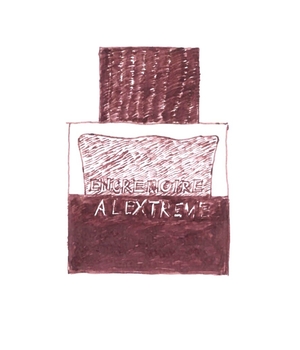 Lalique has been associated with perfume since 1907, when its founder, René Lalique, began to produce alluring glass bottles for the prodigiously entrepreneurial French perfumer François Coty. But it wasn’t until 1992 that the company launched a perfume of its own with Lalique de Lalique.
Lalique has been associated with perfume since 1907, when its founder, René Lalique, began to produce alluring glass bottles for the prodigiously entrepreneurial French perfumer François Coty. But it wasn’t until 1992 that the company launched a perfume of its own with Lalique de Lalique.
Encre Noire – literally ‘black ink’ – was released in 2006, and was quickly hailed as one of the best vetiver scents around. Created by the talented perfumer Nathalie Lorson from the Swiss fragrance-and-flavour firm Firmenich, it blends good-quality vetiver (whose earthy, slightly bitter smell comes from the roots of a tropical grass) with the woody notes of cypress and a long-lasting synthetic called Cashmeran, whose effect is as plush as its name.
Though Encre Noire is still available, and presumably a steady seller, Lalique has celebrated its 10th anniversary by launching a slightly more powerful, punchy version called Encre Noire à l’Extrême. Created again by Nathalie Lorson, the new perfume blends two different vetivers, one from Haiti and the from Java, and adds touches of iris, incense, sandalwood and patchouli.
If rather stronger and heavier than the earlier Encre Noire, it’s still a very attractive fragrance, and while Lalique claims that Encre Nore à l’Extrême ‘redefines masculinity’, we feel that it would smell equally appealing on a man or a woman. Think ink.
Lalique
Encre Noire
15 April, 2015
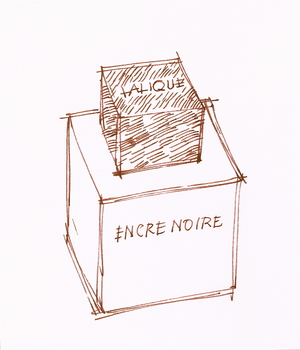 Calling a perfume ‘black ink’ has intriguing connotations. ‘Black’ or ‘Noir(e)’ has been the perfume industry’s shorthand for ‘edgy’ ever since the 1998 launch of the striking but hard-to-wear Bulgari Black. Among the many followers in its wake we’ve had Ambre Noir, 1881 Black, Armani Privé Cuir Noir, Bois Noir, Coco Noir, Cologne Noir, Dahlia Noir, Datura Noir, Eau Noir, Fourreau Noir, even (I kid you not) Hello Kitty Noir.
Calling a perfume ‘black ink’ has intriguing connotations. ‘Black’ or ‘Noir(e)’ has been the perfume industry’s shorthand for ‘edgy’ ever since the 1998 launch of the striking but hard-to-wear Bulgari Black. Among the many followers in its wake we’ve had Ambre Noir, 1881 Black, Armani Privé Cuir Noir, Bois Noir, Coco Noir, Cologne Noir, Dahlia Noir, Datura Noir, Eau Noir, Fourreau Noir, even (I kid you not) Hello Kitty Noir.
So Encre Noire (which was launched in 2006) follows a bit of a bandwagon, though at least its name is better than most. It’s a nostalgic name, since hardly anyone uses ink (black or otherwise) these days, yet it’s evocative too – I can kind of imagine the smell of black ink, even though I must have been a teenager the last time I opened an actual bottle of the stuff.
Whatever you think about the name, Encre Noire is a fine addition to the many men’s perfumes to be based on the smell of vetiver, the vigorous tropical grass whose roots have a wonderful dry, earthy, slightly musky scent. My all-time favourite is Guerlain’s simply-named Vétiver, which starts with a burst of lemony freshness, but Encre Noire foresakes such tricks and sticks resolutely with vetiver all the way through.
I say ‘all the way through’, but of course it’s actually a bit more complicated than that, thanks to Nathalie Lorson, senior perfumer at the giant Swiss fragrance company Firmenich. When she created Encre Noire she cleverly smoothed off some of vetiver’s rough edges, adding tiny amounts of cypress extract (which has a dry, woody, slightly resinous smell), as well as synthetic musk and so-called ‘cashmere wood’. This is actually 2,3,5,6,7-hexahydro-1,2,3,3-pentamethyl-4h-inden-4-one, a chemical sold under the brand name of Cashmeran, which is widely used in perfumery (and household products) and has a soft, gently woody smell.
The final result an appealing and long-lasting perfume, though some people are always going to find vetiver too dry and bitter-smelling for their taste. As for the bottle, a black glass cube with a square wood-effect cap, I like its inkwell look, but its glossy surfaces all too quickly get smeared with fingerprints, and the lettering is so spare – just a bare ENCRE NOIRE in thin white sans-serif capitals – that (to me at least) it ends up looking a bit cheap and half-considered, though I’m sure it was anything but.
Minor gripes aside, this is a fine perfume, and even if, in the end, I think it’s unlikely to supplant Guerlain’s Vétiver in my affections, I think its popularity is well deserved.
Paco Rabanne
Black XS for Men
9 July, 2014
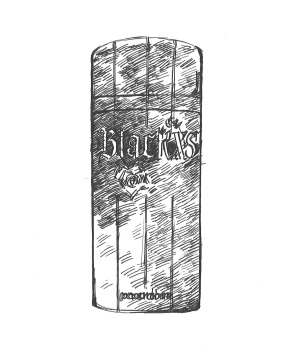 Perfumes can suggest many things. They can be uplifting, outrageous, disgusting, sexy, hard, delicious, warm, cold, luxurious, even sad. It might seem a bit far-fetched to describe a perfume as silly, but that’s what I think of Black XS by Paco Rabanne, and it’s also why I like it.
Perfumes can suggest many things. They can be uplifting, outrageous, disgusting, sexy, hard, delicious, warm, cold, luxurious, even sad. It might seem a bit far-fetched to describe a perfume as silly, but that’s what I think of Black XS by Paco Rabanne, and it’s also why I like it.
Created by Oliver Cresp (co-creator of Thierry Mugler’s love-it or loathe-it Angel) at perfume powerhouse Firmenich and licensed to fragrance multinational Puig, Black XS was launched in 2005. Its black-glass flip-top bottle originally came in an outer slip-case with a shirtless photo of the English model and amateur boxer Will Chalker, which added to its charm.
Packaging aside, its appeal is pretty simple: pump the spray button and you get an unexpectedly fruity blast of ripe strawberries – sweet, girly and completely at odds with the rather Gothic / Twilight-style design and lettering of the bottle. It’s not what you’d call a complex fragrance, but occasionally it’s fun to forget about trying to be cool and sophisticated: perfumes, like people, can sometimes take themselves too seriously, and there’s a silliness about Black XS that makes me smile every time I spray it on.
What’s really funny, though, is that Black XS doesn’t actually have any strawberry in it at all – at least it’s not among the official list of ingredients. What it does have is lemon, calamanzi (a kind of orange native to the Philippines), sage and what most perfume sites describe as ‘tagete’, which I’m assuming is an illiterate corruption of Tagetes, the Latin name for marigold.
The Mexican marigold, Tagetes erecta, is the source of an oil used in perfumery because of its attractive appley scent, and I wonder whether it’s the combination of orange, lemon and apple that fools my nose into thinking that what I’m really smelling is strawberry? If the effect is intentional it’s dead clever, but it’s the kind of thing that professional perfumers do all the time. Personally I think it’s magic.
Christian Dior
Eau Sauvage
3 March, 2014
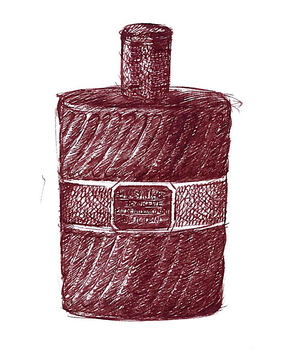 How did I get this far without reviewing Eau Sauvage? And now that I’ve finally got round to reviewing it, how am I going to do justice to such an iconic perfume? OK, I’ve covered Eau Sauvage Extrême, but that’s a dreary spin-off and bears little relation to the glorious real thing. So, deep breath now, and here we go.
How did I get this far without reviewing Eau Sauvage? And now that I’ve finally got round to reviewing it, how am I going to do justice to such an iconic perfume? OK, I’ve covered Eau Sauvage Extrême, but that’s a dreary spin-off and bears little relation to the glorious real thing. So, deep breath now, and here we go.
Created by the legendary perfumer Edmond Roudnitska, Eau Sauvage was launched in 1966, and it’s deservedly regarded as one of the greatest men’s perfumes of all. Roudnitska’s took the idea of a classic men’s cologne, packing it full of fresh, zingy, clean-smelling bergamot-orange oil from southern Italy, but then he did a brilliant thing, by blending it with an equally strong dose of a recently patented chemical called Hedione.
Hedione smells of jasmine – as well it might, since it was discovered by chemists during the process of deconstructing the molecular bits and bobs that, collectively, create natural jasmine’s heady, narcotic scent. Hedione’s real name is methyl dihydrojasmonate, and it was first isolated in 1958 by Dr Edouard Demole, who worked for the giant Swiss perfume company Firmenich.
Methyl dihydrojasmonate has a light jasmine smell but also something citrusy about it, giving Edmond Roudnitska a jigsaw piece that fitted into both the bergamot orange of a man’s cologne, and also had something – but crucially not too much – of natural jasmine’s sumptuous, powerfully floral scent, which most men would have considered far too feminine to wear.
To this Roudnitska added lavender – another floral scent, though this time one whose herby, faintly sweaty character had made it a long-standing male favourite – as well as a range of other, less pronounced ingredients including oakmoss (originally extracted from a lichen that smells of forests after rain) and patchouli, which in small amounts, I’m guessing, enhances the dandified character of Eau Sauvage without pushing it over into full-on let-it-all-hang-out hippiness.
A great perfume is one thing, and an all-too-rare thing at that, but it’s rarer still for a brilliant perfume to be supported by great marketing and presented in a great bottle. And here Eau Sauvage struck lucky again. Christian Dior died in 1957 of a heart attack, but under Yves Saint Laurent and then Marc Bohan, the company commissioned a series of sexy, tongue-in-cheek yet effortlessly elegant posters from René Gruau, arguably the greatest fashion illustrator of the 20th century. They certainly added to Eau Sauvage’s masculine appeal.
Few of us think a great deal about the bottles that contain the perfume we use, though they do have their collectors (most of whom, oddly, seem to have lost interest in the perfumes they contain). But some bottles repay a second glance, and Eau Sauvage is one of them. It was designed by Pierre Camin, who worked for Baccarat and created many of the bottles for the perfumer François Coty, and its chic silver cap, embossed with a pattern of tiny overlapping scales like a freshly-caught mackerel, is said to have been inspired by the silver thimble that Christian Dior always had to hand. The diagonally ridged sides of the bottle itself, meanwhile, are supposed to resemble the regular pleats of a Dior dress, though that seems a bit of a stretch to me.
I could go on, but in the unlikely event that you’ve never smelled Eau Sauvage, or think of it as a tired old dinosaur, I’d rather you headed out and tried it for yourself. Just be careful, though, as Dior have experimented with different versions over the years, and what’s now called Eau Sauvage Extrême (which you’d think would just be a stronger version, as indeed it used to be) is now a completely different fragrance, pleasant enough in a dull way but far less exciting than the original.
My last words, though, go to Edmond Roudnitska, not only because he was a perfumer of genius, but also because he also had something so important to say about marketing that it should be tattooed on the forehead of every perfume-company PR.
‘The choice of a perfume,’ he said, ‘can only rest on the competence acquired by education of olfactive taste, by intelligent curiosity and by a desire to understand the WHY and the HOW of perfume. Instead, the public [is] given inexactitudes and banalities. The proper role of publicity is to assist in the formation of connoisseurs, who are the only worthwhile propagandists for perfume, and it is up to the perfumers to enlighten, orient and direct the publicity agents.’
Here’s to the day his dream comes true.
Guerlain
Guerlain Homme l’eau Boisée
18 January, 2014
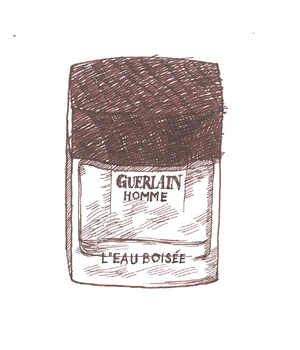 Few perfume companies have such a great heritage (and so many perfumes) as Guerlain, which is presumably why the luxury behemoth LVMH bought it in 1994. Founded in Paris in 1828 by Pierre-François Guerlain, it reached its apotheosis in the late nineteenth and early twentieth century under Pierre-François’ grandson Aimé (who concocted the wonderful Jicky in 1898) and Aimé’s nephew, Jacques Guerlain.
Few perfume companies have such a great heritage (and so many perfumes) as Guerlain, which is presumably why the luxury behemoth LVMH bought it in 1994. Founded in Paris in 1828 by Pierre-François Guerlain, it reached its apotheosis in the late nineteenth and early twentieth century under Pierre-François’ grandson Aimé (who concocted the wonderful Jicky in 1898) and Aimé’s nephew, Jacques Guerlain.
One of the greatest perfumers of all time, Jacques created a whole series of legendary fragrances between 1906 and 1925, whose names are almost as alluring as the scents themselves: Après l’Ondée in 1906, L’Heure Bleue in 1912, Mitsouko in 1919, Shalimar in 1925, and Vol de Nuit in 1933.
Jacques’ grandson, Jean-Paul Guerlain, continued the family tradition, creating many superb fragrances of his own, for women and for men, including three of my own personal favourites – Vétiver (1959), Habit Rouge (1965) and Héritage (1992). But his reign ended sadly: after the Guerlains sold out to LVMH, Jean-Paul became just one of Guerlain’s hired hands, and in 2010 even his post-retirement role as a consultant was terminated after he made a casually racist remark on French television.
I’ll return to some of my own favourite Guerlain perfumes in future reviews, but I’ve recently been given, very generously, a bottle of Guerlain Homme L’eau Boisée, and as I rather like it I thought it would be good to feature something that was only released in 2012.
L’eau Boisée was created by Thierry Wasser, the Swiss-born perfumer who, before he took over from Jean-Paul Guerlain in 2008, worked for the multinational fragrance company Firmenich and was responsible for perfumes as diverse as Dior’s Addict, Diesel’s Fuel for Life and Kylie Minogue’s Darling.
Wasser’s original Guerlain Homme was released, to mixed reviews, the same year that he joined the company in-house. With a nice touch of wit, it’s based on the smell of a mojito, the Cuban cocktail whose ingredients include white rum, spearmint leaves and lime juice, but it’s been generally described as a fairly mass-market men’s fragrance – perfectly wearable, at least, but hardly up there with Habit Rouge or Jicky.
Since then, impelled by perfume retailers’ insatiable (and ultimately self-defeating) demands for novelty, Wasser has so far created three further versions of Guerlain Homme: Intense (2009), L’eau (2010) and L’eau Boisée. This last is a soft, woody fragrance, whose initial fresh scent of lime fades fairly quickly, to be followed by the warm scent of cedar wood and the pleasantly earthy smell of vetiver (Wasser uses a special vetiver from Tamil Nadu in southern India, apparently, rather than the more usual variety from Haiti or Réunion).
I can’t smell rum in L’eau Boisée, but to me it does have a faint but not unpleasant smell of celery, and a faintly sweaty (but again not unpleasant) scent that reminds me of a bottle of Penhaligon’s Hammam Bouquet that I used up years ago – must go and have a sniff to compare.
Would I rush out and buy a bottle? I’m not sure I would, as it’s hardly a groundbreaking scent; but as new perfumes go it’s both pleasant and rather refined, the kind of thing you could safely buy for an uncle or a friend. I’d be interested to know what you think.